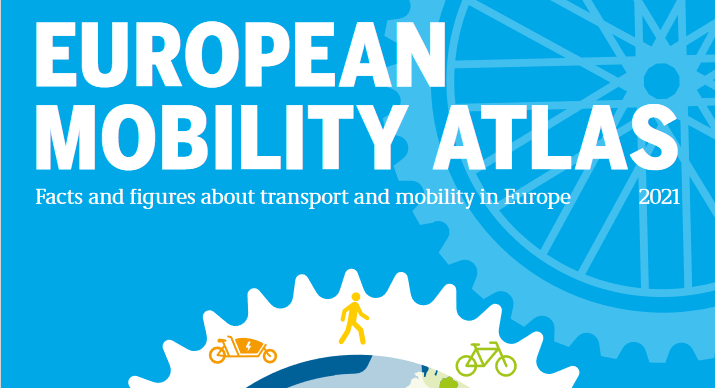Making up nearly 30 percent of emissions within the EU, the transport sector needs to be radically transformed if we are to reach climate neutrality by 2050. The EU Mobility Atlas from the Böll Foundation gives us the latest about the state of our transport system and the prospect of a future for sustainable travel in Europe.
Under the Paris Agreement, the transport sector in the EU must become climate neutral by 2050. Electric vehicles, smart digital solutions and traditional fossil-free transport options offer huge potential, yet the transformation we need is still far from being realised. Current infrastructure is still built around fossil fuels – from roads, to airports, to petrol stations – which need to be replaced with green alternatives, including more bike lanes, cross-border rail tracks, and more charging points for EVs. Moreover, green transport infrastructure relies on a regular supply of green energy, which means the current capacity of green power in Europe needs to be increased substantially.
When it comes to climate targets, the European Commission certainly talks the talk, however. Their 2011 white paper entitled ‘Roadmap to a Single European Transport Area—Towards a competitive and resource efficient transport system’ outlined their intention to achieve a 60 percent cut in transport emissions by 2050: by getting rid of all combustion engine vehicles in cities, achieving a 40 percent cut in shipping emissions and moving half of all medium distance inter-city travel from road to rail and boats.
But is it walking the walk? The 2021 European Mobility Atlas from the Heinrich Böll Foundation offers a comprehensive overview on the current state – and the future prospects – of sustainable travel in Europe in the wake of the coronavirus.
Planes, trains and automobiles
With the onset of the coronavirus pandemic, air traffic plummeted, and levels of air travel are still far from being back to normal. The reduction in flights gave many a glimmer of hope that perhaps this would mark the beginning of a new era of green cross-border travel. Unfortunately this has not been the case. European Airlines have received billions in government bailouts since the beginning of the crisis, and often with no climate conditions attached.
It is common knowledge that flights are damaging to the planet, but the extent of their impact tends to be underestimated. According to the 2021 Mobility Atlas, at current rates, aviation emissions could make up as much as one quarter of the world’s carbon budget by 2050 – if we are to stay within a safe 1.5 degree warming limit.
 Böckmann, Duwe-Schrinner, Kurzhöfer, CC BY 4.0
Böckmann, Duwe-Schrinner, Kurzhöfer, CC BY 4.0Airlines have promised to become greener, but the expected gains in fuel efficiency are set to be far outweighed by the predicted 4 percent annual growth of the industry. Moreover batteries are too heavy to make long-haul electric flights feasible. Going green for the airline industry ultimately means relying on either biofuels or carbon offsets – but both of these solutions can in many scenarios actually do more harm than good, for example by leading to more deforestation or over-estimating sequestration potential and encouraging further emissions. The Stay Grounded Network proposes a frequent-flyer levy, and a moratorium on airport expansion, and limiting short-haul flights. The key to any solution will be to end the tax exemptions and regulatory advantages that airlines enjoy over more sustainable alternatives. These roughly amount to subsidies of 30-40 billion euros annually across the EU, even before the Covid bailouts.
With cars, the news is a bit more promising. A number of countries in the EU have pledged to phase out new combustion engine cars between 2025-2040. As a result, manufacturers are increasingly focussing their R&D on alternative fuel vehicles. Meanwhile the EU’s post-coronavirus stimulus packages have been aimed at boosting sales of electric cars, for example by providing financial incentives to customers and investing in more charging stations.
However Europe is still lagging behind in the electric car market. Only four of the top twenty manufacturers of electric cars are European and out of 15.2 million cars sold in 2018 in Europe, only 150 thousand were purely electric. However, two out of three Europeans surveyed think car manufacturers are not doing enough to promote good air quality, which suggests that consumers are ready for change.
 Böckmann, Duwe-Schrinner, Kurzhöfer, CC BY 4.0
Böckmann, Duwe-Schrinner, Kurzhöfer, CC BY 4.0On average a fast charging station can be found every 60km on European highways, but the infrastructure available for charging electric cars is uneven across Europe. In central and south-east Europe, it is inadequate for driving long distances. With hydrogen cars, the situation looks even less promising – Germany for instance has only 70 filling stations. Making the transition to electric cars is even more imperative after the pandemic, as many people have shifted long distance journeys away from public transport and towards cars where it’s easier to ensure social distancing.
The European Commission has proposed to make 2021 the year of the rail. Currently there are technical compatibility issues between different national rail systems, which the EU aims to overcome with the introduction of a single EU-wide railway signalling system, ‘European Rail and Traffic Management System (ERTMS). Meanwhile six new sleeper train routes were announced in December, to be completed by 2024.
However Europe remains very far from a unified rail system, and the share of passenger rail in land transport is just 7.8 percent, and 80 percent of that is domestic travel. Part of the problem is financing, both in that there is not enough (a problem which has been exacerbated by the pandemic due to reductions in passenger numbers), and that there are disputes as to who should pay for cross-border lines. Another is that members states continue to focus on high-speed lines with limited cross-border connectivity. However there is big potential for rail – especially because it has the advantage of long-term reliability if well maintained, and it requires much less maintenance than roads.
Cycling on the rise in times of social distancing
The bicycle industry was the only real winner during the pandemic; and sales sky-rocketed. This was partly due to active government encouragement of cycling, which was promoted as a way to stay active whilst maintaining social distancing. Berlin, for example, created a number of pop-up cycle lanes, which look likely to remain in the long term. Other countries have implemented special subsidy schemes, especially for cargo bikes.The growth was also due to the rapid rise in popularity of e-bikes, which now make up 17 percent of bike sales. 3.4 million e-bikes were sold in Europe in 2019, expected to increase to 13.5 million annually by 2030. The number of e-bikes on the market already far outweighs the number of e-cars.
In addition to e-bikes, cargo bikes and bike trailers are becoming increasingly popular among private citizens, as well as for commercial use. A network of cargo bike-sharing schemes has emerged across Germany and Austria, whereby commons bikes are rented without a fee – the biggest fleet of 120 bikes is ‘fLotte’ in Berlin. Cargo bikes have the advantage of being relatively low-cost, easy to maintain, and able to carry three times their own weight (with transport capacity between 40kg and 250kg). Modern cargo bikes can come with an electrical assist.
 Böckmann, Duwe-Schrinner, Kurzhöfer, CC BY 4.0
Böckmann, Duwe-Schrinner, Kurzhöfer, CC BY 4.0The combination of e-bikes and cargo bikes have the potential to substitute motor vehicles for approximately half of all journeys within cities: a stated goal outlined by EU transport ministers in the 2015 ‘Declaration on Cycling as a Climate Friendly Transport Mode.’
However, for this potential to be fully realised, better infrastructure is needed – including bike lanes that are protected, and are wide enough for all types of bikes. In addition, secure parking areas, plus small design features like bike pumps along cycle paths and foot rests at traffic lights will help encourage cycling. Copenhagen, where they have invested heavily in such infrastructure, is on track to meet their 50 percent of all journeys by bicycle target by 2025.
Sustainable tourism – or business as usual?
Though tourism brings in a lot of revenue – contributing to 10.3 percent of the EU’s GDP – ‘overtourism’ was becoming a problem in many European destinations prior to the pandemic. The prime example is Venice, which had 25 million tourists a year, despite having a population of only 55 thousand. Tourism had begun to threaten the way of life for residents in many major destinations across the continent.
The growth of the tourism industry also had, of course, a major impact on the environment. Tourist air travel for instance grew by 15 percent between 2012-2017. Encouragingly, 50 percent of respondents (and 56 percent of those born after 1990) in a recent survey stated that environmental sustainability was an important consideration in their choice of holiday destination. This new mindset is exemplified by Germans, 5.5 million of whom went on a long distance cycle trip in 2018.
Post-pandemic, the tourism sector also seems to acknowledge that going back to business as usual is not an option. The EU Tourism Manifesto Alliance, the voice of the travel and tourism sector, recently stated to the EU Commission that the crisis is “an opportunity to change, for a new beginning in tourism across Europe.” However, it remains unclear how far such lessons will be remembered once the pandemic is truly behind us.
Increased digitalisation powers sustainable transportation
Digitalisation is changing urban mobility. While digital transportation services currently remain fragmented between many different companies and apps, the next probable step is the aggregation of services and the combining of all mobility options into a single app. This Mobility as a Service (MaaS) idea has strong support among EU citizens, according to a recent survey.
 Böckmann, Duwe-Schrinner, Kurzhöfer, CC BY 4.0
Böckmann, Duwe-Schrinner, Kurzhöfer, CC BY 4.0Digitalisation and smartly planned intermodal intersections also offer a way forward for people living in rural areas, who have less access to public transport and often have little option than to use private cars. But people in rural areas often don’t live too far from transport links – the problem is rather how to transport a person ‘the last mile,’ e.g. between a station and their home. For example Park&Ride or Bike&Ride facilities at stations are the most basic formulation of infrastructure to change between private and public transport. But with the advance of technology, there is much greater room to expand such facilities, for example by providing closed bike boxes for electric bikes, charging points for electric cars, and car sharing and bike sharing services. Digitalisation makes it easier to plan journeys across different modes of transport, and allow for more demand-driven solutions.
However, while the promising digital developments were expected to continue in the years to come, and help decarbonise the transport sector, the pandemic has posed a major stumbling block, and has made the development somewhat uncertain – particularly when it comes to shared transport services such as Uber and BlaBlaCar.
In sum, it appears that while there have been some promising steps forward in certain areas in recent years – for example when it comes to cycling – for many other sectors, however, there is still a long way to go. For example, while billions are still spent every year subsidising aviation, rail and other greener transport services suffer from under-investment and a lack of essential supporting infrastructure. Recovery packages to overcome the effects of the coronavirus pandemic will have to be accompanied by a commitment to transforming the sector if Europe is to reach its climate goals, and enjoy low-carbon, more inclusive and connected transportation in the future.
You can read the full European Mobility Atlas 2021 here.






